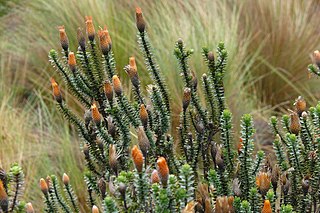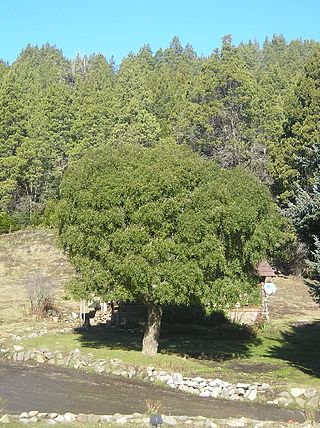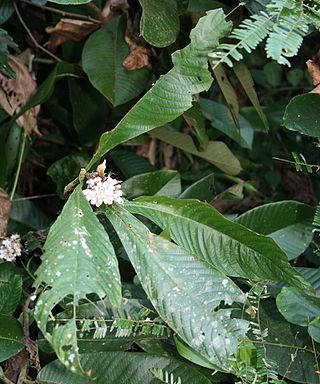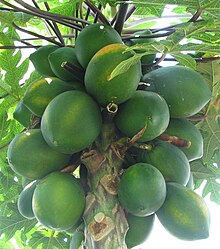
The papaya, papaw, or pawpaw is the plant species Carica papaya, one of the 21 accepted species in the genus Carica of the family Caricaceae, and also the name of its fruit. It was first domesticated in Mesoamerica, within modern-day southern Mexico and Central America. It is grown in several countries in regions with a tropical climate. In 2022, India produced 38% of the world's supply of papayas.

The mountain papaya also known as mountain pawpaw, papayuelo, chamburo, or simply "papaya" is a species of the genus Vasconcellea, native to the Andes of northwestern South America from Colombia south to central Chile, typically growing at altitudes of 1,500–3,000 metres (4,900–9,800 ft).

The babaco, is a hybrid cultivar in the genus Vasconcellea from Ecuador. It is a hybrid between Vasconcellea cundinamarcensis, and Vasconcellea stipulata although Vasconcellea weberbaueri has also been mentioned as a contributor to the hybrid.

Cissus is a genus of approximately 350 species of lianas in the grape family (Vitaceae). They have a cosmopolitan distribution, though the majority are to be found in the tropics.

Cauliflory is a botanical term referring to plants that flower and fruit from their main stems or woody trunks, rather than from new growth and shoots. It is rare in temperate regions but common in tropical forests.

Rauvolfia is a genus of evergreen trees and shrubs, commonly known as devil peppers, in the family Apocynaceae. The genus is named to honor Leonhard Rauwolf. The genus can mainly be found in tropical regions of Africa, Asia, Latin America, and various oceanic islands.

The Caricaceae are a family of flowering plants in the order Brassicales, found primarily in tropical regions of Central and South America and Africa. They are usually short-lived evergreen pachycaul shrubs or small to medium-sized trees growing to 5–10 m tall. One species, Vasconcellea horovitziana is a liana and the three species of the genus Jarilla are herbs. Some species, such as the papaya, bear edible fruit and produce papain.

Vasconcellea is a genus with 26 species of flowering plants in the family Caricaceae. Most were formerly treated in the genus Carica, but have been split out on genetic evidence. The genus name has also been incorrectly spelled "Vasconcella".

Cleome is a genus of flowering plants in the family Cleomaceae, commonly known as spider flowers, spider plants, spider weeds, or bee plants. Previously, it had been placed in the family Capparaceae, until DNA studies found the Cleomaceae genera to be more closely related to the Brassicaceae than the Capparaceae. Cleome and clammyweed can sometimes be confused.

Chuquiraga is a genus of flowering plants in the family Asteraceae. The genus is distributed in the Andes from Colombia to Chile, with most species occurring in Patagonia.

Maytenus is a genus of flowering plants in the family Celastraceae. Members of the genus are distributed throughout Central and South America, Southeast Asia, Micronesia, and Australasia, the Indian Ocean and Africa. They grow in a very wide variety of climates, from tropical to subpolar. The traditional circumscription of Maytenus was paraphyletic, so many species have been transferred to Denhamia and Gymnosporia.

Mycetia is a genus of flowering plants in the family Rubiaceae. It includes 54 species, ranging from the Indian subcontinent through Indochina, southern China, and Malesia to New Guinea.

Papaya Lethal Yellowing Virus (PLYV) is an isometric viral plant pathogen, tentatively assigned to the genus Sobemovirus, that causes lethal yellowing disease of the papaya plant.

This is a list of plants found in the Sierra de Manantlán Biosphere Reserve. The reserve straddles the Mexican states of Colima and Jalisco. It is located in the transition between the Nearctic and Neotropical realms and encompasses parts of the Sierra Madre del Sur, with a wide range of altitudes, climates and soils. The effects of tectonic and volcanic activities and erosion are notable within the reserve.

The flora of the Philippines boasts a diverse array of plant species given its location in the great Malaysian flora. The Malaysian Phytogeographic zone is considered to be one of the most important centers for plant diversity because of the multitude and variance of species occupying that zone. The archipelago is isolated by a continental and deep ocean.
















